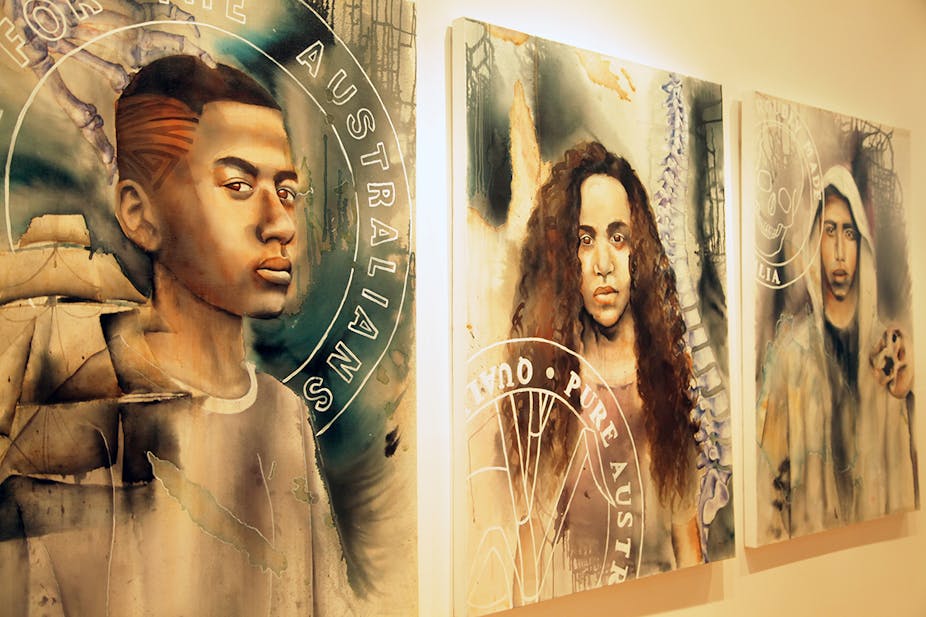On the wall hang three portraits of contemporary South Pacific Islanders, some with ships and all with duty stamps in the foreground. Skulls of sealed raw sugar glisten on a table. Bitter Sweet is the most striking installation in Blak Dot Gallery’s DNA (Deadly Nui Art) Exhibition, part of the 2014 Melbourne Fringe Festival. Curated by Kimba Thompson, DNA is also the last exhibition at Blak Dot Gallery until they find a new space.
The artist is Jasmine Togo-Brisby of fourth generation Australian South Sea Island and Anglo-Australian heritage. According to her artist statement, the installation is a memorial to the over 62,000 South Pacific Islanders who were stolen (e.g. blackbirded) to work in the Queensland sugar industry between 1864-1903.

The theme of the DNA (Deadly Nui Art) exhibition is “the concept of DNA as a hereditary self-replicating material”. As in Jasmine Togo-Brisby’s artwork, the six other artists (Tony Tai, Damien Shen, Mariaa Randall, Francis Tapueluelu, Chanel Winarti, and Lily Aitui Laita) explore the replication of the genetic memories of their ancestors.
As demonstrated by the science of genetic memories, information about traumatic experiences is what often gets passed on. The various identities of the artists – hybrid Indigenous Australian, Anglo-Australian, Pakeha, Asian, and/or Pacific Islander heritages – invite reflection on both collective and individual trauma, and resilience.
Tony Tai’s street-pop-art inspired installation seems bright and cosy at first. A side table, lounge chair, bookshelf, and coffee table invite one to have a seat. Fun graphic astronaut helmets are reproduced on graffiti stickers and puzzles. Yet jagged sketches of alien creatures mix with sketches of two brothers and photographs of scenery. One feels the dissonance in the representation of Tony’s mixed Samoan/ Auckland gay male “Urban Oceanic” world.
In contrast, Damien Shen’s work is serene. The fine detail of his classical drawings literally, and lovingly, traces the history of his South Australian Aboriginal, Chinese, and Ngarrindjeri identities in the faces of the three subjects.

A Bundajalung woman, Mariaa Randall’s Paint the Dance is the most mesmerising of the artworks. The piece pairs a stark black-on-white-wall painting with an adjacent projected video. In the 8.5 minutes video, Mariaa slowly rolls across a white wall in a dress steeped in black dye and pulls back masking tape to form patterns. It emerges that the video is Mariaa’s process of producing the painting on the wall, which is a map of Country.

Frances Tapueluelu’s five-piece Brains is the most explicit in addressing the DNA theme of genetic memory as trauma and resilience. Her first brain, covered with Tongan tattoos, is called “my genetic memory”. The second brain represents the boat as the home and the sea.
The third brain, called “overload”, is pierced with tagged issues of discrimination. The fourth brain has a knife sticking out of it with paper ribbons listing the symptoms of a brain tumour. The fifth brain represents both Christian and traditional Tongan symbols of faith.
More subtle, Chanel Winarti’s installation is a shrine to a female ancestor in a black and white portrait. The Balinese Anglo Australian artist offers the ancestor Kopiko brand coffee candy and flowers on woven mats. Red Head brand matches lie next to offerings of fragrant incense. The act of making offerings encodes the genetic connection.
Lily Aitui Laita’s paintings focus on Samoan formal speech (faalupega). Layers of colours overlayed with printed images of pigeon-headed figures encode genetic connections among the artist’s Pakeha, Maori, and Samoan heritages.
The DNA exhibition is on display at Melbourne’s Blak Dot Gallery until October 5. Details here.

